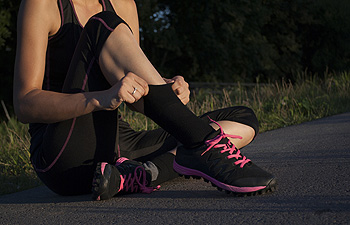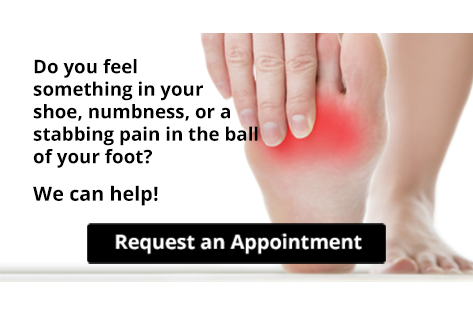Connect With Us
Blog
Items filtered by date: April 2021
What Factors Should You Consider in a Running Shoe?
Running puts a great deal of stress on your feet. In fact, the amount of force your feet endure during running is equal to three times the amount of your weight. This makes your choice of running shoe very important in order to support your feet and ankles, and distribute that force evenly. Your running shoes not only need to be comfortable but offer plenty of cushioning in the midsole and have the foundational structure your foot needs. A podiatrist can advise you on the type of shoe, support, and structure you need based on your individual level of fitness and intended use, any injuries you have or had, and your particular style of running. They may even perform a gait analysis to determine if a specific shoe or custom orthotic is needed to improve the alignment of your hips, knees, and ankles.
For more information about walking shoes versus running shoes, consult with Emil Lavian,DPM from Maven Podiatry. Our doctor can measure your feet to determine what your needs are and help you find an appropriate pair of footwear.
Foot Health: The Differences between Walking & Running Shoes
There are great ways to stay in shape: running and walking are two great exercises to a healthy lifestyle. It is important to know that running shoes and walking shoes are not interchangeable. There is a key difference on how the feet hit the ground when someone is running or walking. This is why one should be aware that a shoe is designed differently for each activity.
You may be asking yourself what the real differences are between walking and running shoes and the answers may shock you.
Differences
Walking doesn’t involve as much stress or impact on the feet as running does. However, this doesn’t mean that you should be any less prepared. When you’re walking, you land on your heels and have your foot roll forward. This rolling motion requires additional support to the feet.
Flexibility – Walking shoes are designed to have soft, flexible soles. This allows the walker to push off easily with each step.
If you have any questions, please feel free to contact our office located in New York, NY . We offer the newest diagnostic and treatment technologies for all your foot care needs.
Read more about Differences between Walking and Running ShoesWhy Live with Pain and Numbness in Your Feet?
Sudden Foot and Ankle Injuries in Children
Children, like adults, can incur sudden foot and ankle injuries while going about their daily activities. Sudden injuries, also known as acute injuries, can occur due to an abnormal movement of the foot or ankle or following a direct blow to the foot. In some cases, a sharp object may puncture the skin of the foot or ankle, creating a puncture wound. Acute injuries can be severely painful and lead to swelling and bruising. Common acute foot and ankle injuries in children include bruises, puncture wounds, injuries to the ligaments, tendons, joints, or muscles, and broken or dislocated bones. If your child complains of foot or ankle pain, please seek the care of a podiatrist.
Making sure that your children maintain good foot health is very important as they grow. If you have any questions, contact Emil Lavian,DPM of Maven Podiatry. Our doctor can provide the care you need to keep you pain-free and on your feet.
Keeping Children's Feet Healthy
Having healthy feet during childhood can help prevent medical problems later in life, namely in the back and legs. As children grow, their feet require different types of care. Here are some things to consider...
Although babies do not walk yet, it is still very important to take care of their feet.
Avoid putting tight shoes or socks on his or her feet.
Allow the baby to stretch and kick his or her feet to feel comfortable.
As a toddler, kids are now on the move and begin to develop differently. At this age, toddlers are getting a feel for walking, so don’t be alarmed if your toddler is unsteady or ‘walks funny’.
As your child gets older, it is important to teach them how to take care of their feet.
Show them proper hygiene to prevent infections such as fungus.
Be watchful for any pain or injury.
Have all injuries checked by a doctor as soon as possible.
Comfortable, protective shoes should always be worn, especially at play.
If you have any questions please feel free to contact our office located in New York, NY . We offer the newest diagnostic and treatment technologies for all your foot and ankle needs.
Read more about What to Do to Keep Your Child’s Feet HealthyWhat Does Athlete's Foot Look Like?
Athlete’s foot, or tinea pedis, is a contagious fungal infection of the skin on the feet. Sometimes, athlete’s foot can be difficult to recognize visually because it can look a lot like dry skin. Nevertheless, there are some telltale signs that indicate a tinea pedis infection. The skin of the feet will typically be very dry, especially on the soles of the feet and in the areas between the toes, and the skin may peel, crack, or blister. Athlete’s foot may also cause a scaly, itchy, red rash to develop on one or both feet. This rash might cause burning or stinging pain. Left untreated, the infection could spread to the toenails and other parts of the body. Fortunately, athlete’s foot can usually be treated with antifungal medications. If you suspect that you may have athlete’s foot, please seek the care of a podiatrist.
Athlete’s foot is an inconvenient condition that can be easily reduced with the proper treatment. If you have any concerns about your feet and ankles, contact Emil Lavian,DPM from Maven Podiatry. Our doctor will treat your foot and ankle needs.
Athlete’s Foot: The Sole Story
Athlete's foot, also known as tinea pedis, can be an extremely contagious foot infection. It is commonly contracted in public changing areas and bathrooms, dormitory style living quarters, around locker rooms and public swimming pools, or anywhere your feet often come into contact with other people.
Solutions to Combat Athlete’s Foot
- Hydrate your feet by using lotion
- Exfoliate
- Buff off nails
- Use of anti-fungal products
- Examine your feet and visit your doctor if any suspicious blisters or cuts develop
Athlete’s foot can cause many irritating symptoms such as dry and flaking skin, itching, and redness. Some more severe symptoms can include bleeding and cracked skin, intense itching and burning, and even pain when walking. In the worst cases, Athlete’s foot can cause blistering as well. Speak to your podiatrist for a better understanding of the different causes of Athlete’s foot, as well as help in determining which treatment options are best for you.
If you have any questions please feel free to contact our office located in New York, NY . We offer the newest diagnostic and treatment technologies for all your foot and ankle needs.
Read more about Athlete's FootSesamoid Bone Injuries
 The sesamoids are small, round bones found in several parts of the body, including the feet. The sesamoids of the feet are roughly pea-sized and are located under the big toe. The sesamoid bones in your feet give you extra leverage and power when pushing your foot off the ground. When repetitive impacts from running or other activities become too much for these bones to bear, they may become inflamed or fracture. A sudden onset of sharp pain in the toe area can be a sign of a sesamoid fracture, while nerve pain or a burning sensation in the toe can indicate nerve damage. Sesamoiditis may cause symptoms such as swelling, tenderness, and difficulty bearing weight. If you are experiencing the symptoms of a sesamoid injury, please seek the care of a podiatrist.
The sesamoids are small, round bones found in several parts of the body, including the feet. The sesamoids of the feet are roughly pea-sized and are located under the big toe. The sesamoid bones in your feet give you extra leverage and power when pushing your foot off the ground. When repetitive impacts from running or other activities become too much for these bones to bear, they may become inflamed or fracture. A sudden onset of sharp pain in the toe area can be a sign of a sesamoid fracture, while nerve pain or a burning sensation in the toe can indicate nerve damage. Sesamoiditis may cause symptoms such as swelling, tenderness, and difficulty bearing weight. If you are experiencing the symptoms of a sesamoid injury, please seek the care of a podiatrist.
Sesamoiditis is an unpleasant foot condition characterized by pain in the balls of the feet. If you think you’re struggling with sesamoiditis, contact Emil Lavian,DPM of Maven Podiatry. Our doctor will treat your condition thoroughly and effectively.
Sesamoiditis
Sesamoiditis is a condition of the foot that affects the ball of the foot. It is more common in younger people than it is in older people. It can also occur with people who have begun a new exercise program, since their bodies are adjusting to the new physical regimen. Pain may also be caused by the inflammation of tendons surrounding the bones. It is important to seek treatment in its early stages because if you ignore the pain, this condition can lead to more serious problems such as severe irritation and bone fractures.
Causes of Sesamoiditis
- Sudden increase in activity
- Increase in physically strenuous movement without a proper warm up or build up
- Foot structure: those who have smaller, bonier feet or those with a high arch may be more susceptible
Treatment for sesamoiditis is non-invasive and simple. Doctors may recommend a strict rest period where the patient forgoes most physical activity. This will help give the patient time to heal their feet through limited activity. For serious cases, it is best to speak with your doctor to determine a treatment option that will help your specific needs.
If you have any questions please feel free to contact our office located in New York, NY . We offer the newest diagnostic and treatment technologies for all your foot and ankle needs.
Read more about Sesamoiditis




